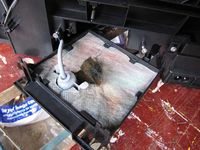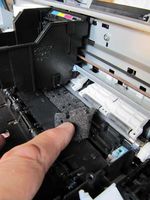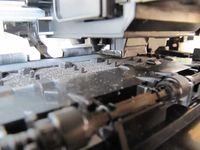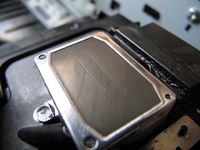Inkjet printers
How to preserve the life or fix inkjet printers.
Summary
The business model adopted by most manufacturers of inkjet printers is to virtually give away the printer and make their money on replacement ink cartridges. Unfortunately this means that it is very unlikely that a professional repair will be cost-effective, except under warranty. It also creates a strong temptation to throw away your printer and buy a new one as soon as it starts playing up, adding to the problem of e-waste. Nevertheless, there are plenty of things you can do to preserve the life of your printer, and give you years of trouble-free service.
Many of the tips on this page are in fact more to do with preventing trouble than fixing it. As with all electronic equipments, check for the usual problems such as loose connections, broken leads, dead power supplies and signs of overheating.
Use it or lose it
Inkjet printers love to be used. Left idle, the print head can dry out and become clogged, resulting in streaky printouts or one colour completely missing. It’s a good idea to print at least a few lines of text containing black and all three colours every couple of weeks. You can use the same sheet of paper at least four times by feeding it into the printer all possible ways round.
You can also help prevent the print head from drying out by keeping your printer away from sources of heat, such as above your computer, near a radiator, or in direct sunlight.
Some printer manufacturers use cartridges with built-in print heads, distinguishable by several dozen gold contacts on the cartridge. Despite being disposable, they might be a better bet in case of light use of a printer as a new cartridge comes with a new print head.
Keeping clean
Once you start getting streaky prints, it’s time to act. Print quality may improve after a page or two, but if not, you need to run a cleaning cycle. Run the utility programme installed with the printer, or select "printer properties" from the printer icon and locate the "cleaning cycle". Follow it with a test print. In the same location you may also find a utility to align the print heads, which you can use if the three colours don’t quite line up. Sometimes, several cleaning cycles may be needed to get a satisfactory test print. Try leaving it for a while between cleaning cycles, as this may give dried-out ink time to soften.
Unfortunately cleaning cycles use a lot of ink, and the cost of the cartridges might quite quickly mount up. If you already refill your own cartridges you can keep going more or less as long as you like, and maybe even try a flushing solution, but a refill starter kit and chip re-setter (essential for chipped cartridges) would go a good way towards the cost of a new printer.
Radical measures can be employed by the manufacturer such as removing the print head for deep cleaning or the use of flushing ink, but Advanced Servicing is kill-or-cure for the owner. Treat it as a learning exercise with a modest chance of a refurbished printer as a bonus.
Third-party and refilled-ink cartridges can save you money and be more environmentally friendly. Manufacturer’s branded ink is carefully formulated for its physical and chemical properties, but compatible ink quality varies. It's worth researching the best options for your specific printer model. A compromise might be to use branded ink during the warranty period but thereafter only for colour if you want top-quality colour photos. Refilling your own cartridges might be a viable proposition for heavy users, though there is an initial outlay, and you may in fact be better off with a budget laser printer.
When using refilled or compatible cartridges, you may receive premature "low-ink" warnings. You can probably ignore them if print quality is still good, but keep an eye on it. Some manufacturers chip their cartridges to discourage refilling or third-party alternatives. These can be distinguished by (typically) 7 gold contacts on the cartridge. A "chip resetter" is available from various sources. This is an essential accessory if refilling your own chipped cartridges.
Last but not least, don't forget that you can save significant amounts of ink by printing in draft mode, and paper by printing double-sided whenever possible. Most printers these days offer "manual duplex" mode, in which you return the paper to the input hopper to print the reverse sides. Ensure the ink is dry before printing the second sides, to avoid paper mis-feeds.
Dealing with paper jams
Paper jams can be caused by poor quality paper. All paper should be stored so as to keep it absolutely bone dry. Take care not to force anything when clearing a paper jam, but at the same time ensure there are no torn scraps left behind. An air duster may help. Also check that the rollers are clean.
Printers are sometimes jammed by foreign objects such as paper clips that have fallen into them. If it's not clear what's causing a jam, get a torch and really explore inside to see if you can find anything unexpected, or tip the printer upside down to see if anything falls out or rattles inside.
Software woes and strange errors
Software problems can best be tackled by checking the manufacturer’s site for driver updates, or by reinstalling the driver. Reboot between uninstalling and reinstalling. If you upgrade your computer and find there’s no driver for your printer, search online for possibly compatible drivers for newer printers of the same brand.
Finally, if a printer you’ve nurtured for years suddenly stops working and just flashes lights, it could be the so-called "kill chip". This is not actually a physical chip, but a function of the built-in control software which disables the printer once a non-user replaceable waste ink reservoir is deemed to have reached capacity. There are hacks online for resetting such a printer and prolonging its life for a while, but unless you can replace the reservoir yourself (probably a piece of absorbent material), it might get messy once it really is full. However, take care when downloading from hacking sites as they can be riddled with malware. Check whether others have had a good experience.
Advanced servicing
More advanced servicing is largely in the realm of "kill or cure", but if the alternative is recycling, then by all means have a go.
That said, replacing the waste ink collection reservoir in the case of a printer that has been rescued from the "kill chip" should be feasible. Removal of the entire print mechanism from the outer casing may be necessary, as in the case of the Epson all-in-one, illustrated. In this printer, a plastic tube took the waste ink from a small collection reservoir beneath the rest position of the print head to a separate much larger reservoir. This was retained by two screws and contained a thick pad of felt (one section shown lifted), which should be quite easily replaceable. The ink was helped on its way by a peristaltic pump, driven by the paper feed mechanism.
Look out for an additional waste ink reservoir under the paper path. This collects any ink if the paper has failed to feed. On the illustrated printer there was a small white felt pad beneath each end of a foam strip, (shown lifted). Don't mistake this waste ink reservoir for the main one. It may be necessary to move the print head manually it order to gain access to both ends. This is not normally recommended, but there may be no option. Finding which lever to press in order to release the print head can be tricky.
Deep cleaning of the print head without its complete removal may be possible if you move it to the centre of the paper path. You should then be able to press a pad against it from underneath. You will be unable to see what you're trying to clean, so a photo shows the underside of a print head removed from the printer. (This printer was already a write-off; considerable skill and possibly specialised jigs and alignment procedures would be required to remove a print head and subsequently reinstall it.)
Different brands of printer use different types of ink, so it's important to research online whether to use pure water, a cleaning solution, or a spirit-based cleaner on the cleaning pad. In any case, the ink jets are microscopic and so the chances of clearing any which are completely blocked by dried ink are moderate at best. A cleaning cycle applies pressure, which you will not be able to do.
References
External links
- How to mend ... an inkjet printer, The Guardian, Monday 7 July 2014



